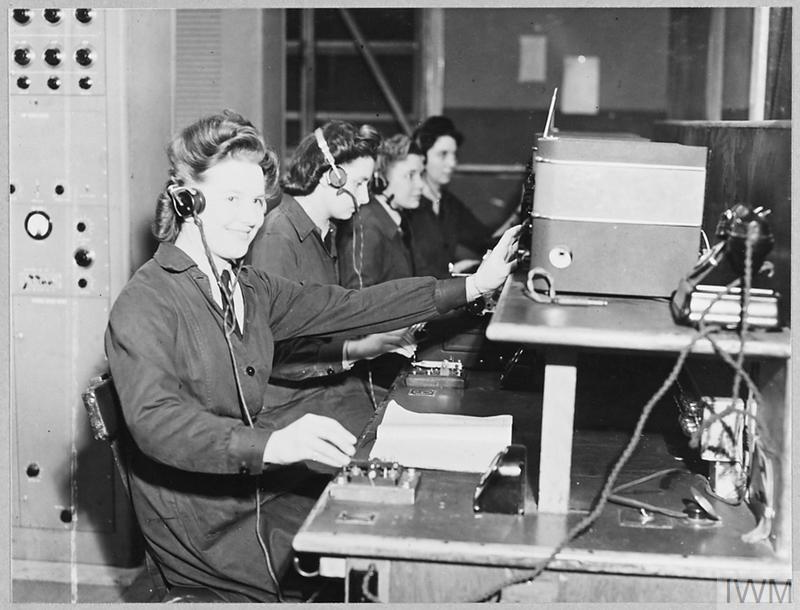As explored in a previous blog (which can be found here), women on the British home front during the Second World War were employed in a number of wartime jobs. These jobs were highly important and helped to bring the Allies to victory. This blog will explore two job roles in particular, those of the Women’s Auxiliary Air Force (WAAF) and those of the Women’s Royal Naval Service (WRNS or Wrens).
Women’s Royal Naval Service



Formed initially in 1917, the WRNS was a branch of the Royal Navy, with its initial intention to free up men for frontline action by employing women in roles such as cooks, dispatch riders and sail makers.[1] After the First World War the Wrens were disbanded and reformed in 1939 when war broke out.
The first female WRNS were admitted to the Royal Naval College in Greenwich, England in 1939, to undertake courses including Officer training, Cipher and Administration and training in radio operating, meteorology and bomb making.[2] Wrens also held important roles at Bletchley Park’s Government Code and Cypher School.
Although few served at sea, the contribution that the WRNS made to the war effort was incredible. At the height of service, approximately 74,000 women were involved in over 200 different jobs with the Wrens.[3] Carrying out active service roles such as loading torpedoes onto submarines, commanding and crewing harbour launches and crewing coastal mine-spotters, 303 Wrens were killed during their wartime service.[4] After the Second World War the Women’s Royal Naval Service was made a permanent part of the Royal Navy, but women did not serve in Royal Navy ships until the 1990s.
Women’s Auxiliary Air Force



Just months after re-formation of the WRNS, King George VI established the WAAF on 28 June 1939.[5] Before this, the female equivalent of the territorial army was the Auxiliary Territorial Service (ATS) however the Government decided before war broke out that a separate women’s air service was necessary. While the WAAF was not an entirely separate organisation, it was also not integrated with the Royal Air Force (RAF). Rather, it linked with its ‘parent’ force in such a way as a substitute where possible women for RAF personnel.[6]
As with the WRNS, the work that women undertook in the WAAF range hugely, from cooking and administrative duties to meteorology and maintaining aircrafts.[7] Aircrew duty was never approved, and while women did fly aircraft during the war, they did so as civilian pilots of the Air Transport Auxiliary.[8] At its peak, in July 1943, 182,000 women were part of the WAAF, and by 1945 a quarter of a million women had served in over 110 different trades. Members of the WAAF served all over the world during the Second World War, and later the WAAF was reformed into the Women’s Royal Air Force (WRAF) in 1949 and finally fully integrated into the RAF in 1994.
[1] Ros Moore, “Wrens: Who Were They And What Did They Do?,” Forces Net, last accessed 10 February 2023, https://www.forces.net/news/wrens-who-were-they-and-what-did-they-do
[2] Old Royal Naval College, “The Wrens,” last accessed 10 February 2023, https://ornc.org/our-history/royal-naval-college/the-wrens/
[3] Old Royal Naval College, “The Wrens”
[4] Moore, “Wrens: Who Were They And What Did They Do?”
[5] Royal Air Force Museum, “Women’s Auxiliary Air Force (WAAF) 1939-1949,” last accessed 10 February 2023, https://www.rafmuseum.org.uk/research/online-exhibitions/women-of-the-air-force/womens-auxiliary-air-force-waaf-1939-1949/
[6] Royal Air Force Museum, “Women’s Auxiliary Air Force (WAAF) 1939-1949”
[7] Royal Air Force Museum, “Women’s Auxiliary Air Force (WAAF) 1939-1949”
[8] Royal Air Force Museum, “Women’s Auxiliary Air Force (WAAF) 1939-1949”
[Image 1] Imperial War Museum (IWM), Signal City, A 13708, https://www.iwm.org.uk/collections/item/object/205146980
[Image 2] IWM, Wren despatch riders, A 2828, https://www.iwm.org.uk/collections/item/object/205137176
[Image 3] IWM, Wrens at a Fleet Air Arm Station, 1940, A 1972, https://www.iwm.org.uk/collections/item/object/205136306
[Image 4] IWM, W.A.A.F. Signals Operators, CH 14211, https://www.iwm.org.uk/collections/item/object/205453518
[Image 5] IWM, Award for the best W.A.A.F. Section of Bomber Command, CH 15775, https://www.iwm.org.uk/collections/item/object/205454883
[Image 6] IWM, W.A.A.F. Director opens ‘GEN’ Room at Bomber Command, CH 10726, https://www.iwm.org.uk/collections/item/object/205450306